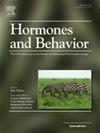Multiparity alters expression of corticotropin releasing factor receptor 1 and co-expression with oxytocin neurons in mice
IF 2.4
3区 医学
Q2 BEHAVIORAL SCIENCES
引用次数: 0
Abstract
Corticotropin releasing factor (CRF) signaling through its primary receptor (CRFR1) regulates various stress-related behaviors and neuroendocrine responses. CRFR1 is also a key regulator of stress-related behavior changes during the postpartum period in rodents. Previous studies indicate dynamic changes in CRFR1 in various brain regions during the first postpartum period including an emergence of CRFR1 expression in hypothalamic oxytocin neurons. We sought to determine how these changes in CRFR1 and CRFR1/oxytocin co-expression might be altered with repeated breeding cycles and whether these neural adaptations coincide with changes in maternal behaviors that are reported to occur in rodent dams with greater maternal experience. CRFR1-GFP reporter mice were bred to produce 1 (primiparous) or 3 (multiparous) litters and were assessed for pup retrieval in unstressed and stressed (male intruder) conditions. Brains of nulliparous, primiparous, and multiparous mice were collected to assess CRFR1-GFP and co-expression of CRFR1 with oxytocin. No statistically significant changes in pup retrieval were found between primiparous and multiparous mice although both groups showed a greater latency to hover over pups following male intruder exposure. However, multiparity increased oxytocin/CRFR1 co-expression relative to primiparous and nulliparous mice in the paraventricular hypothalamus (PVN) and supraoptic nucleus (SON). Multiparous mice also showed elevated CRFR1-GFP in the PVN and SON relative to primiparous mice. In the medial preoptic area and anteroventral periventricular nucleus, primiparous, but not multiparous mice differed in CRFR1-GFP levels relative to nulliparous mice. Together, these findings indicate dynamic changes in CRFR1 with multiparity that may contribute to stress-related behavior changes.
多胎改变小鼠促肾上腺皮质激素释放因子受体1的表达及其与催产素神经元的共表达
促肾上腺皮质激素释放因子(CRF)通过其主要受体(CRFR1)调控各种应激相关行为和神经内分泌反应。CRFR1也是啮齿动物产后应激相关行为变化的关键调节因子。先前的研究表明,在产后第一个时期,CRFR1在大脑各区域的动态变化,包括下丘脑催产素神经元中CRFR1表达的出现。我们试图确定这些CRFR1和CRFR1/催产素共表达的变化是如何随着重复的繁殖周期而改变的,以及这些神经适应是否与母性行为的变化相一致,这些变化发生在母性经验丰富的啮齿动物中。CRFR1-GFP报告小鼠繁殖1窝(初产)或3窝(多产),并在非应激和应激(雄性入侵者)条件下评估幼鼠的回收情况。收集未产、初产和多产小鼠的大脑,评估CRFR1- gfp以及CRFR1与催产素的共表达。在初产和多产小鼠之间,虽然在雄性入侵者暴露后,两组小鼠都表现出更大的徘徊潜伏期,但在幼仔检索方面没有统计学上的显著变化。然而,与初产和未产小鼠相比,多胎小鼠在室旁下丘脑(PVN)和视上核(SON)中的催产素/CRFR1共表达增加。与初产小鼠相比,多胎小鼠PVN和SON中的CRFR1-GFP也有所升高。在内侧视前区和腹侧脑室周围核中,初产小鼠与未产小鼠相比,CRFR1-GFP水平不同。总之,这些发现表明多胎CRFR1的动态变化可能有助于压力相关的行为改变。
本文章由计算机程序翻译,如有差异,请以英文原文为准。
求助全文
约1分钟内获得全文
求助全文
来源期刊

Hormones and Behavior
医学-行为科学
CiteScore
6.70
自引率
8.60%
发文量
139
审稿时长
91 days
期刊介绍:
Hormones and Behavior publishes original research articles, reviews and special issues concerning hormone-brain-behavior relationships, broadly defined. The journal''s scope ranges from laboratory and field studies concerning neuroendocrine as well as endocrine mechanisms controlling the development or adult expression of behavior to studies concerning the environmental control and evolutionary significance of hormone-behavior relationships. The journal welcomes studies conducted on species ranging from invertebrates to mammals, including humans.
 求助内容:
求助内容: 应助结果提醒方式:
应助结果提醒方式:


